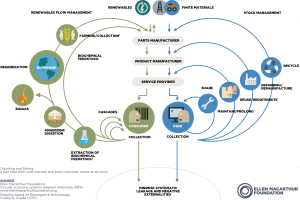Part 6: Duties to the Environment
87 What are linear versus circular economies?
One popular characterization of a company’s environmental efforts is to distinguish between “linear economies” and “circular economies”. In a linear economy, resources are extracted from the earth, transformed into products, used by consumers, and then discarded into landfills. In contrast, a circular economy focuses the production and product usage cycle on reusing, repurposing, and recycling. The following video walks through these concepts:
Review the principles outlined by the MacArthur Foundation, here: https://ellenmacarthurfoundation.org/topics/circular-economy-introduction/overview. The diagram below highlights these principles.

The right side shows circular economy principles for manufactured goods. These include recycling materials, prolonging life, and redistributing. Each of these activities returns the product to usage in a circular manner. The left side shows circular principles for biological goods.

Exercises
- The fast fashion industry is often criticized for following linear economy principles. See https://www.youtube.com/watch?v=MHnDqelUh-4. Draw a diagram of the structure of the fast fashion industry, from creation of garments until their disposal.
- How would you characterize Apple’s products on the butterfly diagram above?
- Patagonia famously created an ad telling customers to not buy its jacket (https://www.patagonia.com/stories/dont-buy-this-jacket-black-friday-and-the-new-york-times/story-18615.html). How does this fit into circular economy principles?

